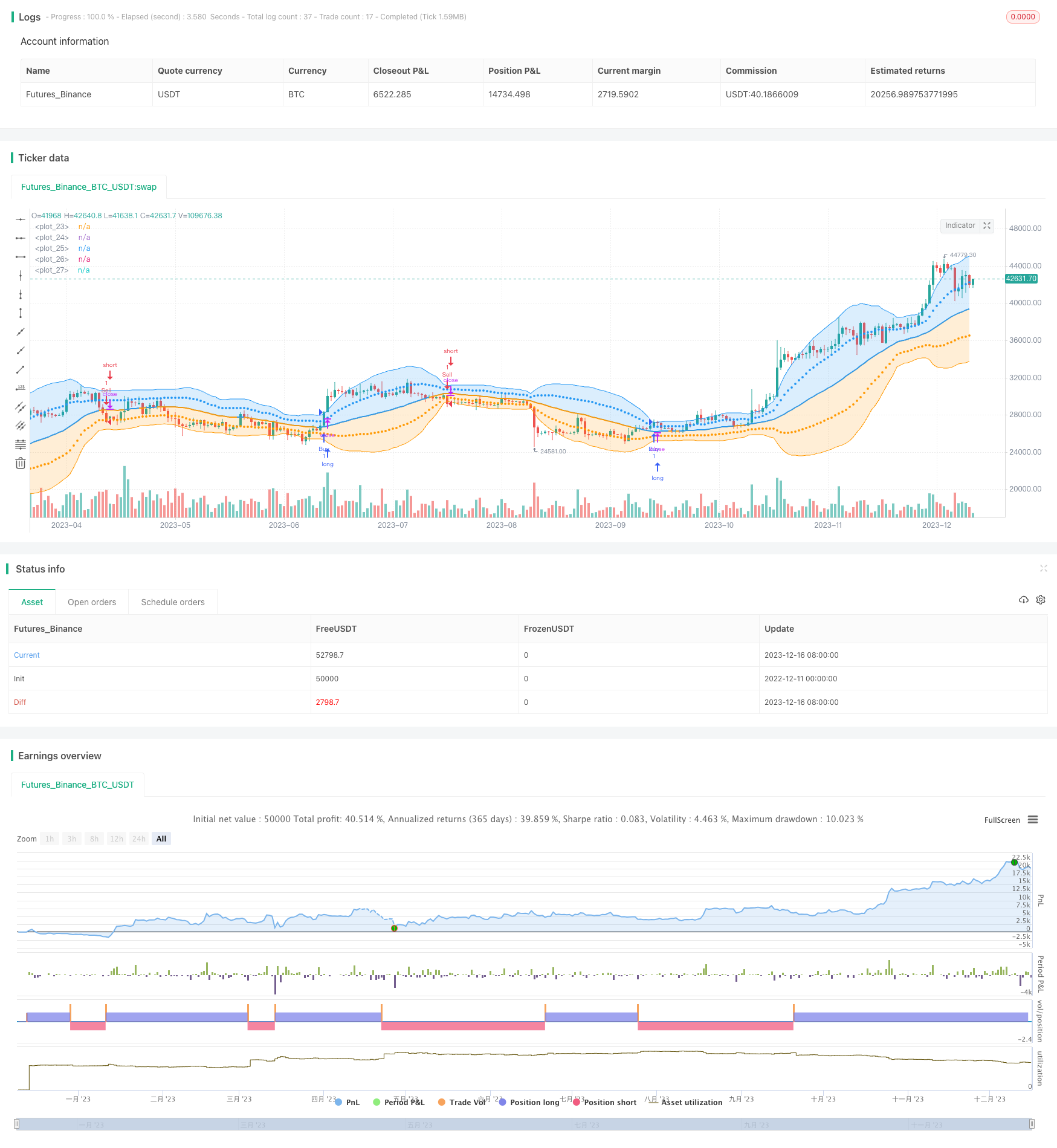
概述
该策略是基于布林带的双标准差模型设计的交易策略。它使用布林带的上下轨及一个和两个标准差作为交易信号。当价格突破布林带上轨时做多,当价格突破布林带下轨时做空。该策略同时使用一个和两个标准差作为止损位。
策略原理
该策略首先计算布林带的中轨、上轨和下轨。中轨是CLOSE的SMA,上轨是中轨+2*标准差,下轨是中轨-2*标准差。当价格突破上轨时产生买入信号做多,当价格突破下轨时产生卖出信号做空。此外,策略还绘制了中轨+1个标准差和中轨-1个标准差的线。它们作为止损位使用。具体逻辑是:
- 计算CLOSE的SMA作为布林带中轨
- 计算CLOSE的标准差STD,并计算2*STD
- 中轨+2*STD为布林带上轨,中轨-2*STD为布林带下轨
- 当价格突破上轨时做多
- 当价格突破下轨时做空
- 中轨+1*STD作为止损线,如果止损线被突破则平仓
策略优势
- 使用双标准差设计,对突破判断更加严格,避免错误信号
- 采用双止损线设计,最大程度控制风险
- 参数优化空间大,中轨周期、标准差倍数都可调整
- 回撤可以通过调整止损位来控制
策略风险
- 布林带策略容易产生假突破,引发交易信号不准确
- 双标准差和双止损线设定可能过于严格,导致信号少剔除机会
- 参数设置不当可能增大策略风险
- 回撤控制并不完善,无法有效控制极端行情下的亏损
策略优化方向
- 可以考虑结合其他指标过滤布林带交易信号,避免假突破
- 可以测试不同参数设置,优化参数以获得更好收益回撤比
- 可以设计动态止损机制,比如跟踪型止损或余额比例止损
- 可以结合机器学习算法自动优化参数
总结
该策略整体来说是一种典型的布林带突破策略。它使用双标准差提高信号判断严格程度,并采用双止损线主动控制风险。该策略有一定的参数优化空间,通过调节中轨周期、标准差倍数等参数可以获得更好的策略表现。同时,该策略也存在布林带策略普遍面临的假突破问题。此外,止损机制也有待进一步改进和优化。
策略源码
/*backtest
start: 2022-12-11 00:00:00
end: 2023-12-17 00:00:00
period: 1d
basePeriod: 1h
exchanges: [{"eid":"Futures_Binance","currency":"BTC_USDT"}]
*/
//@version=5
// Bollinger Bands: Madrid : 14/SEP/2014 11:07 : 2.0
// This displays the traditional Bollinger Bands, the difference is
// that the 1st and 2nd StdDev are outlined with two colors and two
// different levels, one for each Standard Deviation
strategy(shorttitle='MBB', title='Bollinger Bands', overlay=true)
src = input(close)
length = input.int(34, minval=1)
mult = input.float(2.0, minval=0.001, maxval=50)
basis = ta.sma(src, length)
dev = ta.stdev(src, length)
dev2 = mult * dev
upper1 = basis + dev
lower1 = basis - dev
upper2 = basis + dev2
lower2 = basis - dev2
colorBasis = src >= basis ? color.blue : color.orange
pBasis = plot(basis, linewidth=2, color=colorBasis)
pUpper1 = plot(upper1, color=color.new(color.blue, 0), style=plot.style_circles)
pUpper2 = plot(upper2, color=color.new(color.blue, 0))
pLower1 = plot(lower1, color=color.new(color.orange, 0), style=plot.style_circles)
pLower2 = plot(lower2, color=color.new(color.orange, 0))
fill(pBasis, pUpper2, color=color.new(color.blue, 80))
fill(pUpper1, pUpper2, color=color.new(color.blue, 80))
fill(pBasis, pLower2, color=color.new(color.orange, 80))
fill(pLower1, pLower2, color=color.new(color.orange, 80))
// Entry conditions
longCondition = ta.crossover(close, upper1)
shortCondition = ta.crossunder(close, lower1)
// Entry and exit strategy
strategy.entry("Buy", strategy.long, when=longCondition)
strategy.entry("Sell", strategy.short, when=shortCondition)
strategy.close("Buy", when=shortCondition)
strategy.close("Sell", when=longCondition)